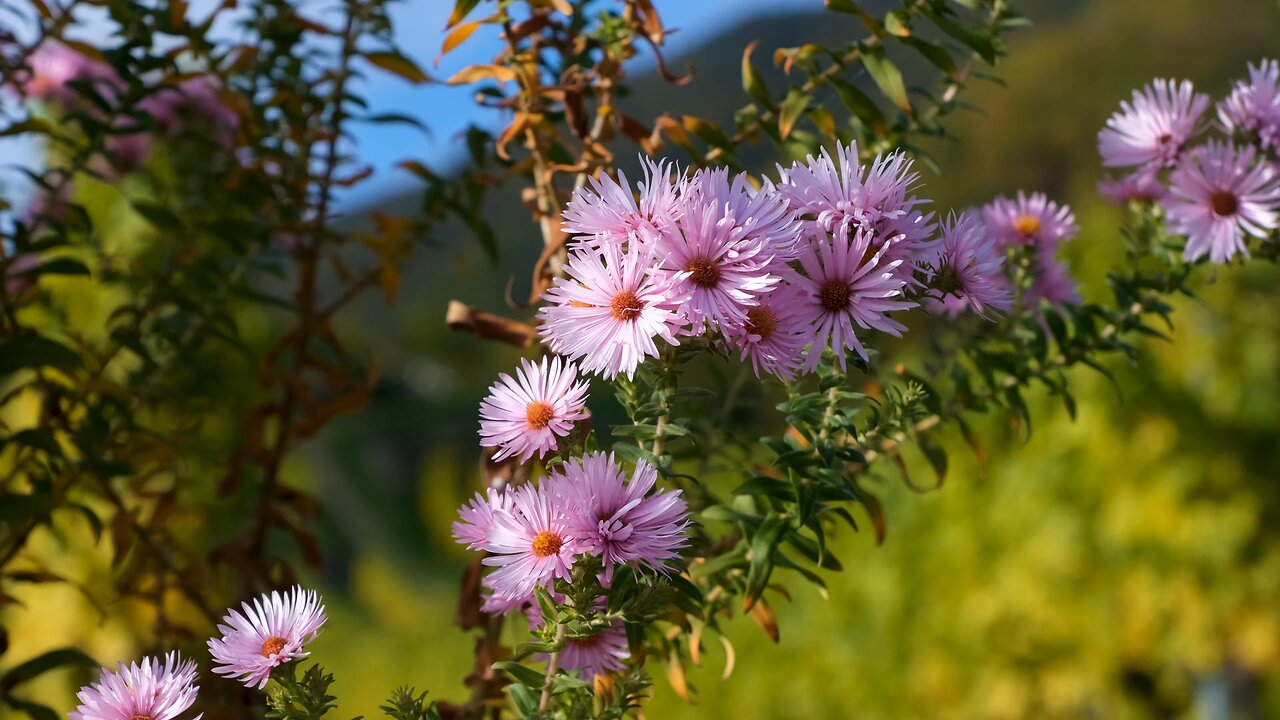Premium Only Content

"The Radiant Charm of Asters"
Asters, particularly the ones in the image you've shared, are a beloved group of flowering plants known for their vibrant, daisy-like blossoms and their role in extending the floral season into late summer and autumn. Here's a detailed look at asters:
### **Botanical Classification**
- **Family:** Asteraceae
- **Genus:** *Aster* (in the broad sense, though many species previously classified under *Aster* have been reclassified into other genera, such as *Symphyotrichum* and *Eurybia*).
- **Common Names:** Michaelmas daisy, frost flower, starwort.
### **Physical Description**
- **Flowers:** Asters feature composite flowers with a central disk surrounded by petal-like ray florets. The disk florets are usually yellow, while the ray florets come in shades of purple, pink, blue, and white. The flowers are typically about 1 to 2 inches in diameter.
- **Leaves:** The leaves are usually lance-shaped, simple, and arranged alternately along the stems. The foliage can vary from dark green to slightly greyish-green, depending on the species.
- **Height:** Aster plants can range from about 1 foot to 6 feet tall, depending on the species and growing conditions.
### **Habitat and Distribution**
- Asters are native to various regions, including North America, Europe, and Asia. They thrive in a variety of habitats, from open fields and prairies to woodlands and mountain slopes.
- They prefer full sun but can tolerate partial shade. Asters are adaptable to different soil types, though they perform best in well-drained, loamy soil.
### **Flowering Season**
- The flowering season for asters typically spans from late summer to early autumn (August to October). This timing makes them valuable for adding color to gardens when many other flowers have finished blooming.
### **Ecological Role**
- **Pollinator Attractor:** Asters are crucial for pollinators, especially late in the season when other nectar sources are scarce. Bees, butterflies, and even some species of moths are frequent visitors.
- **Wildlife Support:** The seeds of asters are a food source for birds and small mammals, while the dense growth can provide cover for small creatures.
### **Cultivation and Care**
- **Watering:** Asters require regular watering, especially during dry periods. However, they are somewhat drought-tolerant once established.
- **Pruning:** Deadheading (removing spent flowers) can encourage a second bloom and keep the plant looking tidy. Cutting back the stems in late fall after flowering can also help prepare the plant for the next growing season.
- **Propagation:** Asters can be propagated through seeds, division, or cuttings. Division is commonly done in the spring or fall to manage plant size and encourage vigorous growth.
### **Cultural Significance**
- **Symbolism:** Asters symbolize patience, love, and elegance. They are also associated with wisdom and valor. In some cultures, asters are placed on graves as a symbol of remembrance.
- **Use in Gardens:** Asters are popular in perennial borders, cottage gardens, and wildflower meadows. Their bright blooms and extended flowering season make them a staple in landscape design.
### **Pests and Diseases**
- **Common Issues:** Asters can be susceptible to powdery mildew, rust, and aphids. Ensuring good air circulation around the plants and watering at the base rather than from above can help prevent fungal diseases.
Asters are appreciated not only for their beauty but also for their ecological benefits and relatively easy care, making them a great choice for both beginner and experienced gardeners.
-
 47:39
47:39
Michael Franzese
4 hours agoJewelry King Trax NYC EXPOSES How the Powerful Steal from You
45.3K8 -
 LIVE
LIVE
Slightly Offensive
3 hours ago $2.86 earnedCandace REDPILLS the Masses in BOMBSHELL Theo Von Interview | Guest: Shane Cashman
1,213 watching -
 UPCOMING
UPCOMING
DLDAfterDark
17 minutes agoDLD Live! That Sh... Will Get You K***ed! What To Consider in SHTF
-
 LIVE
LIVE
megimu32
3 hours agoON THE SUBJECT: IRL Streamers Attacked & Nostalgic Animal Movies That Made Us Cry
509 watching -
 1:00:54
1:00:54
The Tom Renz Show
7 hours agoMore Epstein/FBI, a Scary Trade War, & the Dem Echo Chamber
7.49K1 -
 40:43
40:43
Kimberly Guilfoyle
8 hours agoDems Double Down on Delusion-Why? Live with Tony Kinnett & Bo French | Ep.202
77.8K34 -
 1:28:42
1:28:42
Redacted News
6 hours agoBREAKING! SOMETHING BIG IS HAPPENING IN EUROPE ALL OUT WAR IS COMING AGAINST RUSSIA, TRUMP FURIOUS
121K285 -
 47:50
47:50
Candace Show Podcast
6 hours agoBREAKING: Judge Makes Statement Regarding Taylor Swift's Text Messages. | Candace Ep 155
113K113 -
 1:14:23
1:14:23
Josh Pate's College Football Show
3 hours ago $0.29 earnedCFB’s Most Hated Teams | FSU & Clemson Future | Big Ten Win Totals | Star Rankings Overrated?
14.5K -
 1:33:47
1:33:47
CatfishedOnline
5 hours agoGoing Live With Robert - Weekly Recap
27.8K